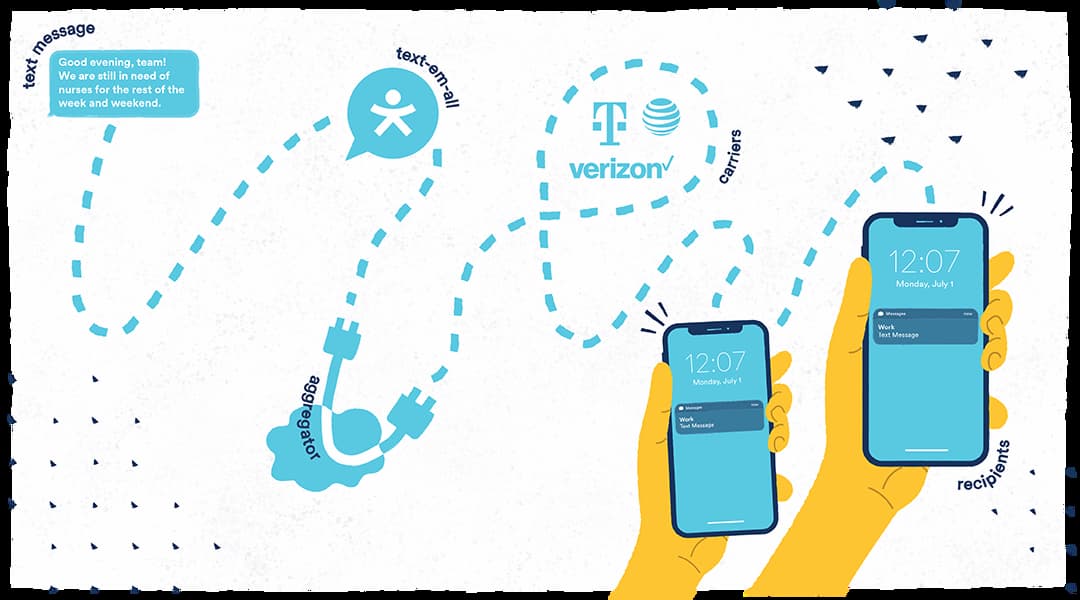
It’s no secret that text messaging has become the preferred method of communication for both personal and business means. With around 23 billion SMS messages sent each day, there is a lot that goes on behind the scenes that people are commonly unaware of. And as more businesses decide to text their customers, questions arise about how automated text messaging services like Text-Em-All technically work.
In this article, we will cover all the steps of the SMS delivery process so that you can better understand the long, complicated journey that a text makes from the Text-Em-All platform to your contacts’ phone. (Don’t worry! We’ve taken all of the technical jargon and put it into terms that everyday people like you and me use).
Step #1 - Businesses & Customers (That’s You!)
First and foremost, there’s you! You are the most important piece to the whole text delivery process because of your choice to send a text broadcast in the first place. You are the drive behind the telecommunications industry because of your need to reach a large group of people! You look to automated mass texting companies, like Text-Em-All, to help deliver personalized, informational, and emergency messages fast - whether they’re going to five people or 50,000.
Step #2 - Application Service Provider (That’s Us!)
Next, there are application service providers. Application service providers have developed elegant solutions for senders who need a ready to use product. For example, Text-Em-All is a web-based software application that enables our customers to send a text broadcast to hundreds or even thousands of recipients in a matter of minutes.
In order to send a text broadcast, every Text-Em-All account is allocated at least one toll-free number (e.i.: 1-800-555-5555). Toll-free numbers are beneficial for several reasons, including:
- High volume messaging is supported
- Reliable delivery to any cell phone or landline in the U.S. and Canada
- Easily recognized and used by 90% of Americans
- Businesses can use existing toll-free numbers for text without affecting their voice service
- Ability to engage in 2-way text conversations
Step #3 - Aggregators
Aggregators connect the application provider (Text-Em-All) to the mobile carriers (AT&T, Verizon, etc.). They act as a gateway to enforcing the compliance regulations set forth by the FTC, CTIA, and individual carriers themselves. Each and every text message must go through an approved aggregator to reach the mobile carrier networks.
Without aggregators, the ease of sending a text message to anyone with a cell phone, which we’ve all grown accustomed to, would not be possible. Aggregators were born from efficiency, solving the need for wireless carriers to send SMS messages between each other, while avoiding the complexity of integrating their huge proprietary networks.
Aggregators are the gateway for sending SMS messages, but their solutions aren’t designed for the end-consumer.
Step #4 - Mobile Carriers
Mobile carriers are also known as providers or operators. There are four national mobile carriers in the United States: AT&T, Verizon, T-Mobile, and Sprint. Each carrier allows only a finite number of aggregators to access their network.
Step #5 - Recipients
Last but certainly not least is the recipient of the text message. You know these folks better than us because you are trying to reach them to distribute important information. These might be your employees, staffing candidates, patients, congregants, students, teachers… you get the idea.
Because we are all about transparency and giving our customers the best information possible, we build a feature that provides detailed delivery results called text delivery receipts. After sending a text broadcast, our system will collect the results of each message from the mobile carriers (e.g., AT&T, Verizon, etc.). You can view these results from your Broadcast Details page by clicking on the specific broadcast from the Home screen. Typically, these results are available immediately, but sometimes mobile carriers can take up to 24 hours to send us detailed results.
Conclusion
When you think about the journey that a text message has to travel, it’s pretty incredible that the message you receive on your phone has passed through all of the steps mentioned above. It’s essential that the application service providers, aggregators, and mobile carriers work together to create a seamless experience between sender and receiver. Get started today by signing up for a free trial.










